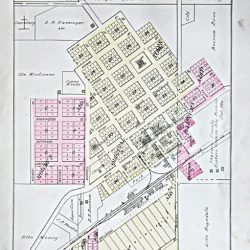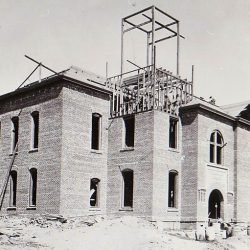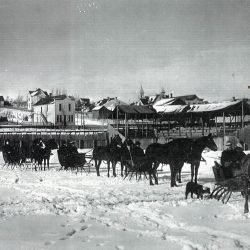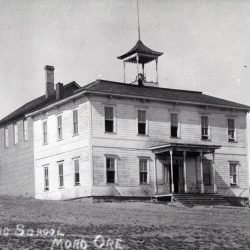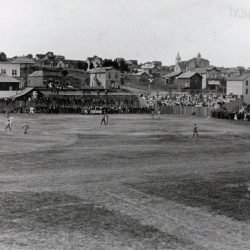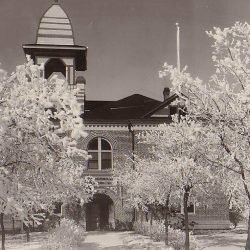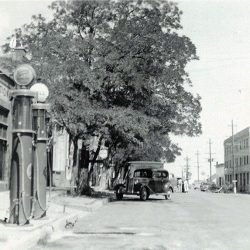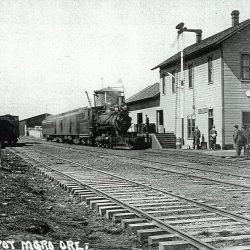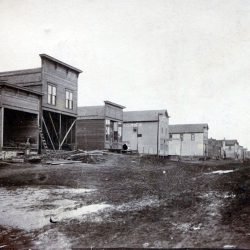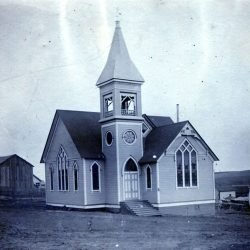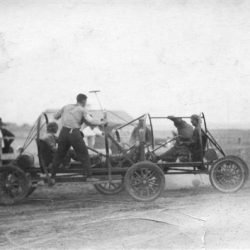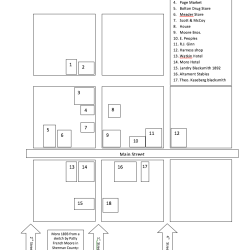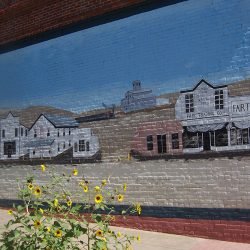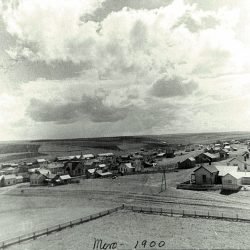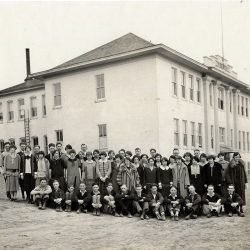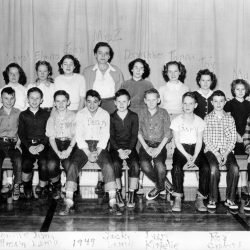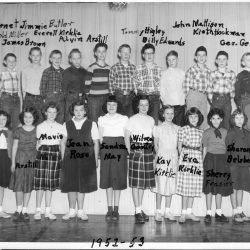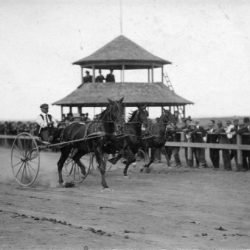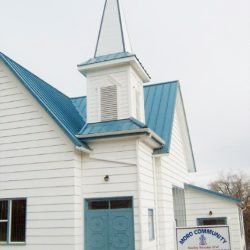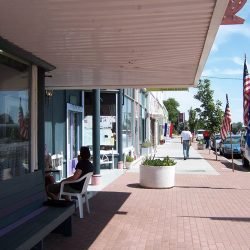Henry Barnum settled here in 1868 and called it Seedum Valley. Moro was selected as the county seat in 1892, some years after the county was formed in 1889, and incorporated in 1899. The first store was built about 1879. The original town site was purchased in 1882 by Scott & Co. and platted by Scott and McCoy, leading merchants, with streets numbered and named: Scott, McCoy and Jewett, First, Second, Third, Fourth and Main. Several versions describe the naming of Moro: 1] Owen McCoy Scott, who came from Moro, Illinois, named it; 2] Melissa Hampton drew the name she submitted from a hat; 3] John Scott, the first postmaster in 1884, wanted a short name to accommodate the correspondence of Scott and McCoy, and that a clerk named Truelove in Scott and McCoy’s establishment came up with the name. However it happened, those present at the christening of Moro were Mrs. Henry Barnum, Mrs. Scott, Melissa Hampton, Mrs. Ragsdale, Mrs. Julius Martin, Hugh Scott, John Scott and Ladru Barnum.
The first building was a general merchandise store built by Scott & Co., and later served as the newspaper office. In 1884 the Moro hotel and McKenzie & Somers’ foundry and blacksmith shop were built. In 1887, the town site passed into the hands of Moore Bros. who established a large general merchandise store and contributed largely to the development of the town.
In 1898, Moro businesses included R.J. Ginn’s well-equipped hardware store, a flouring mill, Moro Mercantile Co., Moore Bros. bank, M. Rosendorf’s dry goods store, an undertaking establishment, two lawyers, two dentists, one physician, several insurance agents, furniture store, harness shop, two hotels, drug store, restaurant, shoe shop, three blacksmith-wagon maker’s shops, a jewelry-watchmaking shop, barber shop, livery stable, millinery store, dressmaker, brick kiln, Troy Laundry, Page & Parry, dealers in livestock, fresh meats, hides and tallow, and a wood, coal and lumber yard. Religious denominations were Presbyterian, Methodist, Baptist and United Brethren.
In 1898 the county seat was connected to the world by a daily stage from Grant, the tri-weekly stage from The Dalles and the Columbia Southern Rail Branch line that reached Moro that year. The town serving a wide circle of farmers and stockmen had a bank, foundry and machine shop, two hotels, livery stables, newspaper, general merchandise store, Friendship Baptist Church, M.E. Church, Presbyterian Church, United Sunday Schools, PHS Local Sherman Circle #320, Woodmen of the World Camp #351, IOOF Moro Lodge #113, AOUW Moro Lodge #64, fire department, blacksmith, brick manufacturer, brick layer, barber, druggist, stationer, teamsters, well digger, laborers, laundry agent, boot and shoe maker, wagon maker, implement dealers, watchmaker, jeweler, fruit grower at Harris on the Deschutes, abstractor, clerk, harness and saddle dealers and manufacturers, attorney, realtor, justice of the peace, dentist, teachers and a public school, insurance agent, Moro Water Company, house and sign painter, telephone company manager, stage line proprietor and hostler.
Moro newspapers included The Sherman County Observer, the county’s first newspaper, which started in Wasco in 1888. In 1889 D.C. Ireland and sons took charge, and A.B. McMillin and C.J. Bright remained as owners. In 1890 it was sold to J.B. Hosford who moved it to Moro in 1891 and called it the Moro Observer. In 1894 Hosford sold to D.C. Ireland and in 1901 Ireland was the majority stockholder. The Moro Leader started in 1898 with L.H. Hunting as editor, succeeded by Fitzmaurice, then William Holder about the time it was moved to Shaniko. In 1902 the Shaniko Leader moved bag and baggage back to Moro and became the Moro Bulletin. The Sherman County News and the Sherman County Journal were also based in Moro. ~French; A.J. Price, SCJ; Fred Lockley; History of Central Oregon, 1905; McArthur, OGN; Harriet J. Scott, 1991; Jack & Violet Noonan; Douthit, The Dalles Times-Mountaineer, Resources of Wasco and Sherman Counties, 1898; USGS Moro Quadrangle; W.P.A. Writers’ Project 1940; Gertrude, Ivalou & Esther Peugh; W.P.A. Writers’ Project 1940; Wasco and Sherman County Directory 1898; SC:FTR 5-1, 10-1, 21-1.
Moro was platted by Scott and McCoy and streets were numbered and named: Scott, McCoy and Jewett, First, Second, Third, Fourth and Main. In 1898, the town had a bank, foundry & machine shop, two hotels, livery stables, newspaper, general store, three churches, fire department, blacksmith, brick manufacturer, barber, druggist, boot and shoe maker, wagon maker, implement dealers, watchmaker, jeweler, harness and saddle shop, attorney, realtor, justice of the peace, dentist, public school, insurance agent, Moro Water Company, painter, telephone company and stage line proprietor.
~ Sherman County Place Names, Streets and Roads, 3rd Edition, 2009, compiled by Sherry (Woods) Kaseberg.
Moro, Oregon 1898
Situated nearly in the center of one of the best wheat-raising sections of Eastern Oregon, and the county seat of Sherman county, is the thriving little city of Moro. While there are not more than about 350 inhabitants at present, there is certain to be twice as many in a very short time. The Columbia Southern railroad is now being constructed from Wasco to Moro, and is expected to be in operation to Moro before the wheat crop, now waving green over our fair county, is ready for market.
Moro is not as yet incorporated, but has many incorporations within her limits — private corporations, for gain and for the public convenience and safety. First to incorporate was the Moro Mercantile Co., capital stock $35,000 — all Sherman county capital — all owned and operated by live business men. They do a general merchandise and machinery business, and have two branch stores, one at Monkland, about 7 miles east of Moro, and the other at Klondike, about 12 miles northeast.
The next to incorporate was the Moro Manufacturing Co., with a capital stock of $4,000, object, to construct and repair all kinds of farm machinery, etc. and operate a foundry. They have a large shop 60 x 60, with annex, and are already in need of more room. They keep several hands busy now, and as soon as all machinery ordered arrives, and is in position, no busier place can be found in Eastern Oregon.
The Moro Publishing Co., incorporated, publishes the Moro Leader, and does all kinds of job printing. The paper is Republican in politics, and keeps abreast of the times on all leading topics.
The Moro Hall Co. is composed principally of members of Moro Lodge No. 64, A.O.U.W., and has nearly completed a fine opera house with an auditorium 32 x 64, and raised stage 18 x 40, with fine lodge room on second floor, with all needful ante rooms, etc.
The Commercial Club had a fine building: front, 26 by 20, two stories, with extensions 22 by 60, completed, and would have opened on May 26th, but the fire-fiend destroyed it in the early morning of that day. Soon as they can it is proposed to rebuild.
The Moro Water Company, just incorporated for $7,000, is going ahead to enlarge the water supply system, putting in larger mains and fire plugs, etc., thus insuring an abundance of fresh water for use, and a magnificent protection against fire.
Moro has a well-equipped fire company, consisting of two divisions, the Hose Company and the Hook and Ladder Company. They are well supplied with hose, cart and hose, ladders, buckets, pull-down hook, etc., and are as proficient as any volunteer fire company anywhere to be found, having but recently proved themselves to be so, saving the town by most energetic and skillful work during the conflagration that destroyed the Commercial Club building and J.B. Hosford’s residence and office.
Moro has two church buildings, one of them erected by the Presbyterians and occupied also by the Methodists, the other Baptist, used at times by the United Brethren. Another fine church will be erected at once by an incorporation of Methodists.
Our public schools are a source of pride and profit, and are well cared for by a board of intelligent and progressive directors. Many pupils attend from outside the town and much interest is taken by all in the success of the schools.
Moore Bros’ Bank is one of our solid institutions, well equipped and well patronized. Moore Bros. are also agents for quite a number of fire insurance companies, and proprietors of the original town site of Moro.
Among the business enterprises not enumerated above, are F. H. Meader & Co., doing a general merchandise and farm implement business; E. Peoples, dealer in furniture, also undertaking; W. O. Hadley, jeweler and watchmaker; A. D. Bolton & Co., druggists and stationery; Dora Williams, stationery, patent medicines, etc. — also post mistress and proprietor of the Moro Hotel, a fine large new house just completed, with annex, consisting of the old hotel heretofore occupied and run as the Moro Hotel; A. E. Cousens, barber and book stand; Mrs. J. H. Landry, fine millinery; Mrs. E. M. West, restaurant and lodging house; Geo. W. Brock, restaurant; L. D. Holder, proprietor of the City Hotel, a large, comfortable and well conducted house; Wheat & Clark, bowling alley, fruit and confectionery stand; Page and Parry, city meat market; Union Lumber Co., lumber, wood, coal, etc.; D. M. Radley, brick-maker, contractor and dealer in lime, cement, etc.; Heydt & Co., makers and dealers in harness, saddles, etc.; Hayes & Dunahoo, proprietors of Altamont Jr. feed and livery stables; S. Monahan, proprietor of Red Barn livery and feed stable; J. H. Landry, blacksmith; Brash & Slater, painters and paper hangers; Windom & Stilwell, house, sign, carriage painting, paper hanging, etc.
Among the professions we find J. B. Hosford, attorney-at-law, who is the leading lawyer of the county; R. E. Hoskinson, another attorney, who is also engaged in the real estate business and insurance; Dr. I. M. Smith, who has been located here for several years, and enjoys a large practice and the confidence of the people. Dr. Lloyd D. Idleman, dentist, a young man from Portland, has established himself here; W. E. Lee, an Iowan, associated at present with R. E. Hoskinson, and L. W. Hunting, justice of the peace, and collector.
Of carpenters, we have C. W. Stokes, Lewis Crandall, Wonderly & Hopkins, Dan Dillinger, Geo. Meader and others.
Moro has a bright future before her, and is to-day a more live, energetic town than many with ten times her population. She has a strong banking house, and her citizens are constantly on the alert for an opportunity to increase business and build up the town and surrounding country.
Many thousands of dollars can be used in developing our native resources. Nowhere in the world is as fine wheat raised for cracker manufacturing, and many thousands of bushels are even now shipped and used exclusively for that purpose.
Several new enterprises are being started, among them a lumber, wood, coal and shingle yard, by J. O. Elrod, a large three-story block being erected by J. R. Martin for business purposes; a flouring mill, and an electric light and power plant, are being seriously contemplated, and just so soon as means are available will be added to our industries.
A fine opportunity for investment in the two last named enterprises. Another Klondike awaiting development is the erection of a number of cottages for rent. There has been a scarcity of residences in Moro for rent constantly for about two years, and the need is certain to be greater as people flock to Moro this summer, as they are sure to do. The completion of the C. S. R. R. to Moro will mark an era in the town’s history, and those who come now, and get in on the ground floor, will reap a rich reward.
This is not a “boom article,” but the plain unvarnished truth, told not with intent to deceive, but to encourage good, honest, reliable people to come and share in our prosperity and make their homes with us.
Moro and her natural advantages will bear close investigation, and any one may learn more of us by coming in person, or addressing Moore Bros., J. B. Hosford, Moro Mercantile Company, R. E. Hoskinson, F. H. Meader & Co., E. Peoples, or any of our citizens. ~ Source: Moro Leader, June 8, 1898, Moro, Sherman Co., Oregon.
Few will have the greatness to bend history itself; but each of us can work to change a small portion of events, and in the total; of all those acts will be written the history of this generation. – Robert Kennedy

